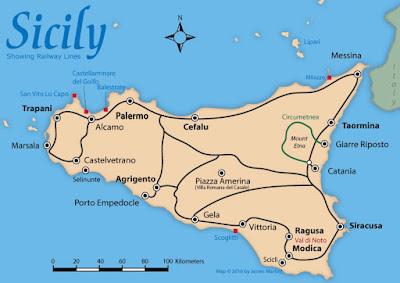
My Nono and Nona emigrated from small villages in the province of Trapani in southwestern Sicily in 1898. My wife and I visited the region between Christmas and New Year, 1990-1991. We stayed in a little coastal village called Marinella di Selinunte, overlooking the Sea of Sicily, part of the Mediterranean Sea. I'm glad we went when we did, because the sea is advancing inexorably on Marinella.
Just down the road from our hotel were the ruins of Selinunte, a major city-state founded by the Greeks around 650 BC. We walked to the site and made our way along a broad expanse leading to the gigantic ruins of the Acropolis of Selinunte. All along the way we were surrounded by huge columns lying scattered about like a child’s building blocks.
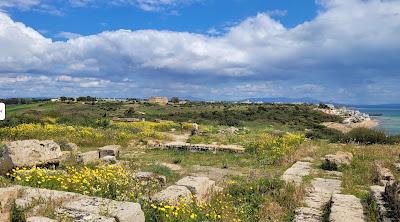
Selinunte was a rich and extensive ancient Greek city of Magna Graecia on the south-western coast of Sicily
In its time, Selinunte had rivaled Athens in its splendor, but like Sicily generally, was subject to the predations of Phoenicians, Greeks, Romans, Byzantines, Arabs, Normans, French, Germans, and Spanish, among others. Today Selinunte is subject to the predations of tourists. Tomorrow, the rising seas, storm surges, and the occasional 'marrobbio' — a major tsunami-like event — will do to Selinunte what time alone could not accomplish — wipe it from history.
We had a wonderful time in Sicily. The weather was sunny, despite it being winter, the scenery was beautiful, the people were friendly, and the food was great; mostly seafood, for which Sicily is rightfully famous.
I particularly remember Rino, our young waiter. He spoke excellent English. His father was born in Sicily, immigrated to the US, and after thirty years decided to return to his homeland, hauling the 13 year-old Rino along. Rino was a tremendous help, since at the that time, relatively few Sicilians spoke English.
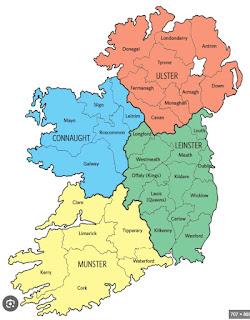
The province populated by the O'Briens is about 2290 mi from that populated by the Badalamentes, in Sicily. Our first stop in Ireland was Navan. On the way there we stopped at a little cafe to have lunch. We were seated next to an elderly lady having tea. She smiled at us, and I struck up a conversation with her, telling her that my wife was of Irish ancestry and had come to Ireland seeking her "roots." She asked her surname, and I told her it was O'Brien. She said, "Ye should visit the graveyards, you'll find plenty there."
Ireland and Sicily share more than an ancestral interest for me. Both are islands, vulnerable to climate change on many fronts, but especially rising sea levels, storm surges, and ocean acidification.
The Sicilian coast, less than 20% of Ireland's, is great for swimmers, with its smooth sand beaches and hidden coves. The Irish coast is great for geologists, with its sheer cliffs and rocky outcroppings. Unfortunately, both coasts make the countries more vulnerable to climate change, just as Florida in the U.S. is more vulnerable to climate change than, say Missouri.
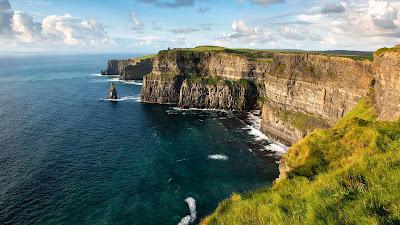
Cliffs of Moher, Ireland
Ireland's 2023 Climate Change Assessment states that, "Storm surges and extreme waves pose an ever-increasing threat to Ireland as sea levels continue to rise, including for many coastal cities such as Cork, Dublin, Galway and Limerick." The Assessment points out the seeming contradiction that heatwaves and flooding due to heavy precipitation may occur together with storm surges, to create challenging adaptation requirements.
A huge concern for the Irish, just as it is for the Sicilians, is migration of fish species due to warming seas. NOAA reports that the temperature of the water in some Irish seas was as much as four and five degrees Celsius higher in 2022 than between 1991 to 2020. Warm water southern fish, like those in the sea off Sicily's southern coast, are becoming increasingly abundant in northern waters, while northern fish more at home in colder water appear to have shifted further north and to deeper water to escape warming.
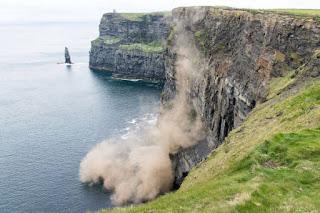
Cliff Collapse, Cliffs of Moher
Climate change poses significant challenges to both Ireland and Sicily, impacting coastal communities, economies, ecosystems, and cultural heritage. Adaptation strategies, such as coastal defense measures, sustainable land use planning, and efforts to mitigate climate change, will be crucial for both regions to cope with these challenges effectively.
Climate change is global. Its effects are felt everywhere from our home here in Washington to our ancestral homes, wherever they may be. When we show concern for the Earth, as we do most visibly every year on April 22nd, "Earth Day," we express our concern for everyone, the friendly people that greeted my wife and I when we visited Sicily, and Ireland, our friends and neighbors here, and indeed for all living things. As Rachel Carson wrote, "In nature, nothing exists alone."
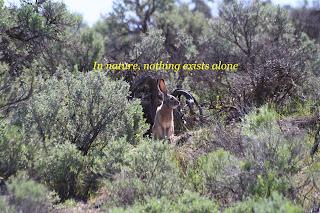
Amon Basin, Richland, Washington
In 'Our Fragile Moment,' Michael Mann writes, "We live on a Goldilocks planet. It has water, an oxygen-rich atmosphere, and an ozone layer that protects life from damaging ultraviolet rays. It is neither too cold nor too hot."
That's our Earth. Celebrate it. Protect and sustain it. Advocate for it. You are the most important factor in ensuring future generations can survive and thrive on our Goldilocks planet.

